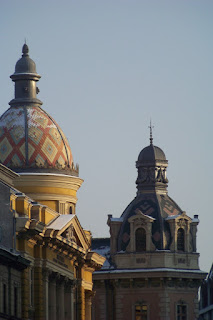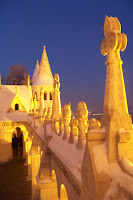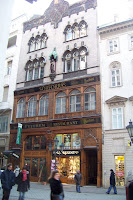 At the beginning of the new year I traveled to Hungary for the first time on family business. The end of the Cold War has been the geopolitical event with the most meaning for my family, allowing us to build deep bonds with families behind the former Iron Curtain that will hopefully endure for the rest of our lives. I have benefited by cultivating lasting friendships in the former East Germany while other members of my family have spent considerable time in Poland, Hungary, Russia and Romania. These ex-communist countries have somehow held a deep fascination among all of us Franco-Americans, possibly in that these countries maintained a sense of foreign-ness that has long been lost in much of Western Europe due to decades of political isolation. The people of these places have also been unusually warm and down-to-earth, failing to exhibit the typically blase and indifferent smugness all too prevalent among Western Europeans.
At the beginning of the new year I traveled to Hungary for the first time on family business. The end of the Cold War has been the geopolitical event with the most meaning for my family, allowing us to build deep bonds with families behind the former Iron Curtain that will hopefully endure for the rest of our lives. I have benefited by cultivating lasting friendships in the former East Germany while other members of my family have spent considerable time in Poland, Hungary, Russia and Romania. These ex-communist countries have somehow held a deep fascination among all of us Franco-Americans, possibly in that these countries maintained a sense of foreign-ness that has long been lost in much of Western Europe due to decades of political isolation. The people of these places have also been unusually warm and down-to-earth, failing to exhibit the typically blase and indifferent smugness all too prevalent among Western Europeans. Arriving in the outskirts Budapest, I was reminded instantly of my year living near Chemnitz only three years after German reunification: a landscaped marked by houses of gray and dull stucco, old busses, and remnants of the dismal Soviet-era architecture. Admittedly the dead of winter is the least ideal time to visit these countries, as the short daylight, snow and barren trees, only intensify the dreariness of structures that beg to be renovated or at least worthy of being torn down. It was closer to my visits to Prague during my year in Germany, in which I stayed with friends in the suburban areas that are defined by cheap concrete construction and unpainted facades. At least the East Germans were receiving generous funds from their western counterparts to renovate most buildings and infrastructure--something the Czechs, Hungarians and Poles were not nearly as fortunate to have.
Arriving in the outskirts Budapest, I was reminded instantly of my year living near Chemnitz only three years after German reunification: a landscaped marked by houses of gray and dull stucco, old busses, and remnants of the dismal Soviet-era architecture. Admittedly the dead of winter is the least ideal time to visit these countries, as the short daylight, snow and barren trees, only intensify the dreariness of structures that beg to be renovated or at least worthy of being torn down. It was closer to my visits to Prague during my year in Germany, in which I stayed with friends in the suburban areas that are defined by cheap concrete construction and unpainted facades. At least the East Germans were receiving generous funds from their western counterparts to renovate most buildings and infrastructure--something the Czechs, Hungarians and Poles were not nearly as fortunate to have.Since there was so much to take in while staying in one of the world's most beautiful cities, writing about it all under one coherent theme was not practical. Instead, multiple themes emerged during my experience:

- Materiality: A noticeable observation when traveling from an American metropolis to an historic European one is the changing qualities of building materials. Simply put, stone is everywhere in cities like Budapest compared to my home of Dallas, which is visually defined by its glassy skyline, mirror-finish metal paneled walls and concrete paving and bridges. Naturally this lends people to identify stone-clad places as 'old' and glass-and-steel clad places as 'new', but a more accurate contrast would be between timelessness and ephemeralness. In my view, any form or object made out of stone somehow never seems to 'get old' in spite of the passing of time, while forms made of modern materials seem to 'get old' the day after its become complete. Part of the reason stems from the fact that stone once formed will last an eternity and that is the product of primal natural forces. Glass, metal and even stucco are man-made derived from natural materials and while they theoretically can last forever, they are diminished relatively quickly by natural forces such as weather, heat and impact. Walking on the streets that feature a mixture between modern and old facades the differences of impression can be striking. On one side, the stone is weathered but its character only enhanced and inherent beauty intact. On the other, a glass curtain wall covered in a film of grime and water stains and condensation, far from its most ideal state when they were new. The irony emerges when one realizes that although a modern curtain wall with precise detailing can be extremely costly, when juxtaposed with a stonewall the former still seems cheap in comparison. Most the city's urban fabric dates from at least one hundred years ago, and much of it remains to be fully renovated since those times; and yet, the richness and vitality of these stone buildings is well intact. I wonder if any other kind of modern material could achieve the same effect.
- Architectural Vocabulary: Like other major capitals of the Hapsburg empire, Budapest exhibits a rich variety of historical styles and stylistic experimentation. In addition to exquisite examples of Gothic, Baroque and Neoclassical, the city is dotted with facades inspired by the Viennese Secession and Belgian Art Nouveau. In each of those styles there is evidence of experimentation and improvisation, giving the buildings a distinctive local character. Being usually mired in contemporary design trends at work, absorbing the rich variety of architectural vocabulary reminded me of the fact buildings indeed do communicate a language. Symbols and recurring ornamental motifs are part of a visual language that not only have the effect of modulating light, shadow, and drainage along the walls, but they also unify cultural artifacts in a harmonious structure. This yields particularly interesting results in Hungary, a land the bridges East and West, Catholic Muslim and Orthodox Christianity, and whose language is completely unrelated to any other European language. Taking in the ecclecticism that ties together Budapest's endless series of monuments, it is evident that the Hungarians do consider themselves unique from their neighbors, but they are still trying to figure out what makes architecture specifically "Hungarian". Flamboyant ogive arches can be seen everywhere, hinting to eastern Byzantine and even Indian roots (it is believed the Magyars came from Asia), while folk-derived cartouche patterns grace the facades of building completed near the turn of the 20th century as part of a Hungarian interpretation of the Viennese "Jugendstil". The colorful roof tile patterns on many of buildings of all historic styles add vibrancy and act as assertive markers to the city skyline. Elaborate murals in both Gothic and Baroque structures exhibit a sort of wavy halo kind of pattern I have found in no other city. In my view it is especially important to closely study architectural ornament of countries who have relatively faint international cultural presence, since it is the most accessible way to somewhat understand who the inhabitants are compared to researching obscure national histories or learning their language. The Austro-Hungarian empire was a fertile context in which to develop a national architectural language, as all these diverse nations were cobbled together but could nev
 er successfully coalesce into a unified political identity. The omnipresence of the exhuberant baroque and the neo-baroque compared to the relative paucity of sober neoclassical in cities like Vienna, Budapest and Prague attest not only to the historic epochs of prosperity but also to a desire for playful and original cultural expression that would differentiate places in this large multi-ethnic empire. Before going to Hungary, I made sure to closely browse an excellent book on the architectural language of the Hapsburg empire that has been all too often overlooked in architectural history surveys.
er successfully coalesce into a unified political identity. The omnipresence of the exhuberant baroque and the neo-baroque compared to the relative paucity of sober neoclassical in cities like Vienna, Budapest and Prague attest not only to the historic epochs of prosperity but also to a desire for playful and original cultural expression that would differentiate places in this large multi-ethnic empire. Before going to Hungary, I made sure to closely browse an excellent book on the architectural language of the Hapsburg empire that has been all too often overlooked in architectural history surveys. - Soviet-era Sprawl: Although we in the States seem to revel in droning on and on about our own brand of urban sprawl, I couldn't help but be grateful that our cities haven't been subjected to an even more jarringly imposing alternative commonly found in all cities and towns behind the Iron Curtain. In the winter, the numerous brownish-grey, pre-fabricated concrete apartment blocks and towers dominate the town's outskirts like tired wooly mammoths at the end of the ice age. The cheap and drab stucco finish is flaking off, the roofscapes are often now topped with corporate billboards, and the outdoor balconies are frequently framed in a hideous orange acrylic panel. The fact that these structures are often taller than the older vernacular structures nearby only intensify their monotony upon the landscape, whereas our suburban tract homes are tempered by growing trees and vegetation over time. One doesn't have to travel all that far from the central historic core before these blocks rear their ugly heads, which should remind us naive Americans about the way many people in Europe actually live: far from joyfully residing in a cozy apartment along a charming historic street, much of the European working and middle class live in these dull and dense blocks that in our country were mostly reserved the extremely destitute (think Cabrini Green). These blocks are not going anywhere as housing is tight and many residents have made them their home for many decades. It makes me kind of appreciate the low-rise wood framed apartment complex that tends to house many of our poor, since they are relatively hidden from view and are constructed to last for no more than a few decades before becoming something else. For those readers who haven't had the chance to encounter Soviet-era sprawl, imagine everything you hate about modern architecture and then deliberately cheapen the materials and limit the colors and textures to the most vomit-like palette. Then build hundreds of the same identical blocks with zero curb appeal and lifeless streets and public spaces. Give me the quiet cracker-jack box suburban subdivision any day
- Lighting Design: For those of us Americans living in lower geographic latitudes, one often forgets how short the daylight lasts in Europe during the winter. By the time I would leave the guest apartment after lunch, the sun alreay began to set. It resulted that I would see many of Budapest's landmarks at night, to which I credit the dramatic artificial illumination that laces the city. During the day visual hierarchy of the city's skyline is determined by dominating forms and profiles such as domes and spires. At night this hierarchy is informed by illumination, with the major monuments brightly lit like lanterns while the rest of the city fabric is submerged in modest street lighting. The most important public squares and the most heavily trafficed streets present themselves as glowing corridors and cavities, like a diagram when perched along the hillside castle on the Buda side. The Danube river comes alive, functioning as reflective canvas to the city's dazzling display of light and dynamism at night. Considering that in many parts of the world the night is as long or longer than the day, a building is only as effective as its ability to manipulate both natural and artificial light. Although most of the old buildings were designed before the advent of electrical lighting, I found that their highly articulated masonry surfaces allowed for a more powerful aesthetic expression under the lights than their sleeker modern counterparts.
- It's all fundamentally about the people: Beautiful architecture can do a lot to impress a visitor, but the quality in the interaction with the local inhabitants marks the experience even more. Though genuinely friendly, I was struck how seldomly the Hungarians I came across actually smiled. I didn't hear much laughter either and the overall mood seemed to be one of indifference and sobriety. I remember the people of Prague to be littel bit more jovial and easy going, always looking for ways to have a good time (beer-drinking is their national pastime). For any city as dependent on foreign tourism as Budapest, the retail experience is at the frontlines of constructing a desired impression on visitors. Shop clerks are do their job competently, but the delivery of the service still leaves a cold impression. I sometimes wonder if the long period of Communistic rule sapped the energy and joy out of the retail experience. There are inefficiencies in how long one must wait in line and in the limited selection of goods. In the subway stations there are far too few ticket counters and way too many ticket inspectors (and the automated machines tend to eat more money than it costs). These of course are all really little nit picks on my part, but other family members were driven to the edge on these little things to the point that they are not determined to visit the city again. Fortunately, I wasn't too annoyed by the level of service at all, since it can't overshadow the architectural richness and romantic urban landscapes of Budapest. I would love to come back again (especially during a warmer time) but we do have to be mindful that for most people, the level of customer service is as important as the level of architectural excellence.





